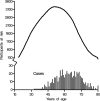Occupational radon exposure and lung cancer mortality: estimating intervention effects using the parametric g-formula
- PMID: 25192403
- PMCID: PMC4524349
- DOI: 10.1097/EDE.0000000000000164
Occupational radon exposure and lung cancer mortality: estimating intervention effects using the parametric g-formula
Abstract
Background: Traditional regression analysis techniques used to estimate associations between occupational radon exposure and lung cancer focus on estimating the effect of cumulative radon exposure on lung cancer. In contrast, public health interventions are typically based on regulating radon concentration rather than workers' cumulative exposure. Estimating the effect of cumulative occupational exposure on lung cancer may be difficult in situations vulnerable to the healthy worker survivor bias.
Methods: Workers in the Colorado Plateau Uranium Miners cohort (n = 4,134) entered the study between 1950 and 1964 and were followed for lung cancer mortality through 2005. We use the parametric g-formula to compare the observed lung cancer mortality to the potential lung cancer mortality had each of 3 policies to limit monthly radon exposure been in place throughout follow-up.
Results: There were 617 lung cancer deaths over 135,275 person-years of follow-up. With no intervention on radon exposure, estimated lung cancer mortality by age 90 was 16%. Lung cancer mortality was reduced for all interventions considered, and larger reductions in lung cancer mortality were seen for interventions with lower monthly radon exposure limits. The most stringent guideline, the Mine Safety and Health Administration standard of 0.33 working-level months, reduced lung cancer mortality from 16% to 10% (risk ratio = 0.67 [95% confidence interval = 0.61 to 0.73]).
Conclusions: This work illustrates the utility of the parametric g-formula for estimating the effects of policies regarding occupational exposures, particularly in situations vulnerable to the healthy worker survivor bias.
Figures



Similar articles
-
Inverse probability weighting to estimate impacts of hypothetical occupational limits on radon exposure to reduce lung cancer.Am J Epidemiol. 2025 May 7;194(5):1295-1303. doi: 10.1093/aje/kwae299. Am J Epidemiol. 2025. PMID: 39168837 Free PMC article.
-
Mortality risk in the French cohort of uranium miners: extended follow-up 1946-1999.Occup Environ Med. 2008 Sep;65(9):597-604. doi: 10.1136/oem.2007.034959. Epub 2007 Dec 20. Occup Environ Med. 2008. PMID: 18096654
-
Healthy worker survivor bias in the Colorado Plateau uranium miners cohort.Am J Epidemiol. 2015 May 15;181(10):762-70. doi: 10.1093/aje/kwu348. Epub 2015 Apr 1. Am J Epidemiol. 2015. PMID: 25837305 Free PMC article.
-
ICRP Publication 115. Lung cancer risk from radon and progeny and statement on radon.Ann ICRP. 2010 Feb;40(1):1-64. doi: 10.1016/j.icrp.2011.08.011. Ann ICRP. 2010. PMID: 22108246 Review.
-
[Uranium exposure and cancer risk: a review of epidemiological studies].Rev Epidemiol Sante Publique. 2004 Feb;52(1):81-90. doi: 10.1016/s0398-7620(04)99024-4. Rev Epidemiol Sante Publique. 2004. PMID: 15107695 Review. French.
Cited by
-
Indoor radon exposure and health risks in a community proximal to gold mine tailings in Gauteng Province, South Africa: a cross-sectional study.Environ Geochem Health. 2025 Aug 7;47(9):363. doi: 10.1007/s10653-025-02677-5. Environ Geochem Health. 2025. PMID: 40772984 Free PMC article.
-
Influence of the atmospheric environment on spatial variation of lung cancer incidence in China.PLoS One. 2024 Jun 18;19(6):e0305345. doi: 10.1371/journal.pone.0305345. eCollection 2024. PLoS One. 2024. PMID: 38889132 Free PMC article.
-
Modeling Combination Interventions to Prevent Human Immunodeficiency Virus in Adolescent Girls and Young Women in South Africa (HIV Prevention Trials Network 068).Clin Infect Dis. 2021 Oct 5;73(7):e1911-e1918. doi: 10.1093/cid/ciaa1598. Clin Infect Dis. 2021. PMID: 33325509 Free PMC article.
-
Union Burying Ground: Mortality, Mortality Inequities, and Sinking Labor Union Membership in the United States.Epidemiology. 2021 Sep 1;32(5):721-730. doi: 10.1097/EDE.0000000000001386. Epidemiology. 2021. PMID: 34224470 Free PMC article.
-
Assessment of the healthy worker survivor effect in cancer studies of the United Autoworkers-General Motors cohort.Occup Environ Med. 2017 Mar;74(4):294-300. doi: 10.1136/oemed-2016-104038. Epub 2017 Jan 9. Occup Environ Med. 2017. PMID: 28069969 Free PMC article.
References
-
- Committee to Assess Health Risks from Exposure to Radon National Research Council . Health Effects of Exposure to Radon:BEIR VI. The National Academies Press; Washington, D.C.: 1999.
-
- Hornung RW, Meinhardt TJ. Quantitative risk assessment of lung cancer in U.S. uranium miners. Health Phys. 1987;52:417–30. - PubMed
-
- Roscoe RJ. An update of mortality from all causes among white uranium miners from the Colorado Plateau Study Group. Am J Ind Med. 1997;31:211–22. - PubMed
-
- Roscoe RJ, Steenland K, Halperin WE, Beaumont JJ, Waxweiler RJ. Lung cancer mortality among nonsmoking uranium miners exposed to radon daughters. JAMA. 1989;262:629–33. - PubMed
-
- Samet JM. Radon and lung cancer. J Natl Cancer Inst. 1989;81:745–758. - PubMed
Publication types
MeSH terms
Substances
Grants and funding
LinkOut - more resources
Full Text Sources
Other Literature Sources
Medical

